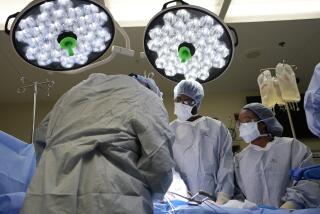On the Cutting Edge
- Share via
AVALON — Jesse Holt doesn’t look like “The Kidney Kid,” a pathfinder in the field of medicine.
Sleepy-eyed, clutching his favorite blanket, he looks like a very normal 1-year-old on the verge of a very deep nap.
But today, Jesse is due to undergo a bold new kind of kidney-removal procedure, one far less invasive than any kidney procedure previously known.
“He has no clue,” said his father, Dennis, 33, a deckhand aboard the glass-bottomed submarines that cruise around Santa Catalina Island. “He was all smiles at the doctor’s office.”
And doctors hope he’ll be all smiles again fairly soon, thanks to the new procedure, called a laparoscopic nephrectomy.
“It really is an amazing surgery,” said Dr. Allan M. Shanberg, who is scheduled to operate on Jesse this morning at UCI Medical Center in Orange.
Instead of making a large incision in the boy’s stomach and removing the defective kidney, Shanberg will make three small cuts, each just a fraction of an inch wide.
Then, a mini-camera will be inserted, along with surgical scissors and a cauterizing tool. The kidney will be broken up and the pieces removed from his body with a suction.
Such a method allows patients to enter the hospital in the morning, have the kidney removed within 90 minutes, then return home that evening.
“It’s minimally invasive surgery,” Shanberg said, “but there’s always a risk, and if problems develop we would have to convert it to an open operation. But the chance of that happening has been fairly low.”
Typically, patients resume normal activity in about two days. In the past, kidney removal required a five-day hospital stay and up to six weeks of recovery.
Jesse’s parents, Dennis and Korinne Holt, learned about his defective kidney before he was born, from a routine sonogram.
“It was pretty scary at first,” Korinne said.
Doctors assured the Holts that Jesse’s other kidney was fine and functioning normally. Still, they recommended removing the defective kidney, to reduce the risk of it becoming cancerous, or causing hypertension or high blood pressure.
“When he was first born and they were telling us all about the operation,” Korinne said, “they said a lot of people have only one kidney functioning and you’d never know it.”
“We’ve had a year to get ready for it,” Dennis said. “And pray about it.”
Though the new procedure is innovative and rare, Shanberg has performed it nearly 30 times, on adults as well as children, at UCI as well as Long Beach Memorial Hospital.
Dr. Richard Ehrlich, a professor of surgery at UCLA, was the first to perform the procedure on a child. He said few doctors now use the laparoscopic approach on children, though he expects that trend to change as surgeons become more comfortable with the challenging procedure.
Roughly 15 doctors nationwide, Ehrlich estimated, perform laparoscopic kidney removal on children, though many more employ the procedure on adults.
“Some [doctors] think the kids are too small, and the instruments are too large,” Ehrlich said. “Once they get over that, it’s a wonderful procedure.”
Ehrlich has performed 60 laparoscopic kidney removals in the past 2 1/2 years, with what he termed “spectacular results.”
Shanberg is presenting a paper on the procedure to the American College of Surgeons at their Jan. 21 Santa Barbara meeting.
By then, Jesse’s memories of the procedure should be fading.
“So much fame,” said Dennis, hugging his son, “for so much pain.”
Times staff writers Julie Marquis and David Reyes contributed to this report.
One year ago, Jesse Holt was born with a defective kidney. It will be removed today using a rare procedure at UCI Medical Center that involves three tiny incisions--and no hospital stay.
More to Read
Sign up for Essential California
The most important California stories and recommendations in your inbox every morning.
You may occasionally receive promotional content from the Los Angeles Times.










